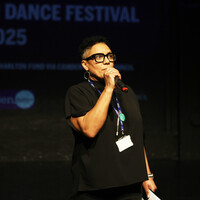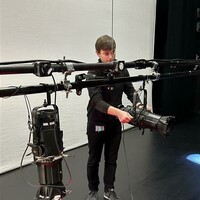Q + A with Josh Slater, Deputy Director of Undergraduate Courses at London Contemporary Dance School
News Story
Josh Slater – Deputy Director of Taught Courses at London Contemporary Dance School – shares more about the Contemporary Dance Performance BA, and the range of experiences students get at the school.
How would you describe the Contemporary Dance Performance BA?
It’s a highly physical, highly practical dance performance course that really focuses on the word ‘contemporary’, but seeing it from an international perspective. It’s not all about the traditional white, western contemporary dance practices. So we’re really thinking about the word ‘contemporary’ in a decolonial and anti-racist way. That means students study lots of different dance practices to develop their versatility as dance artists, to help them go on to work in different fields covered in the programme or in the wider industry.
What will students get out of the course?
Students all learn how to perform, how to do choreography, plus how to be creative and collaborative. And they all learn how to work with different people in different disciplines outside of their course, so they develop into versatile dance artist practitioners. There's a really strong base of technical training, plus they gain the ability to be well-rounded humans in a creative room.
Four pathways were introduced to the programme in 2024. What is the benefit of this to students?
We reviewed what we’re doing, what our graduates are doing, and what the industry needs. We realised we’re doing all the things covered in the pathways on the course anyway, but they were folded in among everything else on the course. It felt like the right thing to do to shine a light on specific aspects of the course through the pathways, which are choreography, advanced physical practice, education and communities, and producing and arts management. It’s helpful for some students in their future careers to have those aspects included in the degree title. Students are still training as contemporary dance performers, regardless of which pathway they’re on. But they’re also honing some additional skills which are greatly needed in the industry.
London Contemporary Dance School is known for its collaborations with prestigious partners. How do students benefit from that?
Students have opportunities to collaborate with outside organisations throughout the course. They particularly enjoy a collaborations project in the third year. Students choose to be a choreographer or a dancer, and they work with either composers from Guildhall School of Music & Drama, or design students from Wimbledon School of Art. They create a brand new piece of work with new music or design, which might involve costumes, set design or objects in a space. The end result is performed in the theatre at The Place. These are well-known moments in our theatre calendar, and they’re well-loved within the school and among the students. These have been long-term collaborations that have happened for a number of years, but we’ve previously also collaborated with RADA and other institutions.
How else do students interact with external organisations?
Students have so many opportunities to collaborate, and this is really connected to our central London location, as we’re the only centrally located dance school. There are so many institutions and big-name creative spaces near us. In the second year, there’s a creative collaborations unit, which is all about students working on small projects with different industry partners. Through this, students have learned from screen dance experts on how to make dance for camera, they’ve worked with the National Centre for Circus Arts, and they’ve worked with University of the Arts London on immersive media, virtual reality and digital technologies. Through this, they get a closer understanding of how dance works with other subjects.
Do students get training and input from experts from outside London Contemporary Dance School?
We’re well-known as an organisation that has dance partners, alumni and professional choreographers who come in and deliver sessions for our students. For example, Hofesh Shechter Company comes in and works with us in a variety of different ways. We commission a lot of artists as part of the degree programme to work with the students and do repertoire work. It’s really core that students have that experience of working with professional choreographers from around the world. There’s a particular focus on third year students working on projects with internationally-renowned choreographers. This includes performances at Wilton’s Music Hall, working on a new piece of work at the theatre at The Place, an improvisation project, and graduate performances – which also happen in the theatre at The Place for five nights. Through all of this, we’re working with external experts all the time. And of course, students also have the opportunity to study abroad for a term, and do an optional placement year between their second and third years.
Periodisation is a unique part of the training at London Contemporary Dance School. What is it, and why is it important?
We were the first dance school to introduce periodisation, and we’re unique in the way we use it. We use it really thoroughly and authentically in the whole timetabling of the course and the way that it’s designed. Periodisation is a sports science terminology and it comes from athletic development. It’s about planning training into phases to maximise gains and reduce the risk of injury or damage. We know it’s a bit of a ‘sciency’ term that prospective students may never have heard before. But we really explain it to them. The purpose is to make sure they have supported training that ensures they're going to have a long career in dance. It’s about ensuring they don’t train in such an intensive way that damages them in the long-term, which would mean they can't dance or be a practitioner for as long as they hope. It means they graduate empowered in how to periodise themselves going into the industry, because it’s not necessarily something they’ll be trained in when they work with companies or on projects.
What’s the feeling like at London Contemporary Dance School?
LCDS is part of The Place, and as a whole organisation, we’re really renowned in Europe for being an innovative contemporary dance space. There’s the theatre, the producing and touring side, and the school itself. Each element is part of the lifecycle of the organisation, and you get a sense of being a part of it, even when you’re not physically there. At all the big festivals in the world, you’ll always come across LCDS alumni or an artistic director, or someone else with a connection to us. It’s got an almost cult-status within contemporary dance circles.
What makes London Contemporary Dance School stand out?
We’re never the ones to see everyone else trying something first – WE will be the ones trying it first. We tried periodisation first, and now this is being distributed throughout the research community and other schools are realising they should do it too. We changed our assessment process to be more ongoing, student-empowered and learning-centred – and not just judging how good someone is in one particular moment. People who have come through the British schooling system can find this hard to understand, because you’re taught to work to assessments by exams. Our approach at LCDS is radical because it’s right. We’re teaching students to become lifelong dancers and dance artists.



